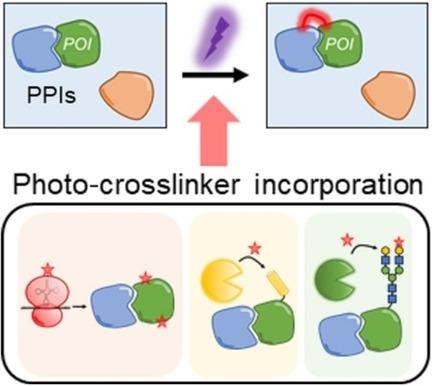当前位置:
X-MOL 学术
›
ChemBioChem
›
论文详情
Our official English website, www.x-mol.net, welcomes your feedback! (Note: you will need to create a separate account there.)
Photo-crosslinking: An Emerging Chemical Tool for Investigating Molecular Networks in Live Cells.
ChemBioChem ( IF 3.2 ) Pub Date : 2020-01-20 , DOI: 10.1002/cbic.201900600 Pratyush Kumar Mishra 1, 2 , Chang-Mo Yoo 1 , Eunmi Hong 3 , Hyun Woo Rhee 1
ChemBioChem ( IF 3.2 ) Pub Date : 2020-01-20 , DOI: 10.1002/cbic.201900600 Pratyush Kumar Mishra 1, 2 , Chang-Mo Yoo 1 , Eunmi Hong 3 , Hyun Woo Rhee 1
Affiliation

|
Studying protein-protein interactions (PPIs) is useful for understanding cellular functions and mechanisms. Evaluating these PPIs under conditions as similar as possible to native conditions can be achieved using photo-crosslinking methods because of their on-demand ability to generate reactive species in situ by irradiation with UV light. Various fusion tag, metabolic incorporation, and amber codon suppression approaches using various crosslinkers containing aryl azide, benzophenone, and diazirines have been applied in live cells. Mass spectrometry and immunological techniques are used to identify crosslinked proteins based on their capture transient and context-dependent interactions. Herein we discuss various incorporation methods and crosslinkers that have been used for interactome mapping in live cells.
中文翻译:

光交联:一种用于研究活细胞分子网络的新兴化学工具。
研究蛋白质-蛋白质相互作用(PPI)对于理解细胞功能和机制非常有用。可以使用光交联方法在与天然条件尽可能相似的条件下评估这些PPI,因为它们具有通过紫外线照射原位产生反应性物质的按需能力。使用各种含有芳基叠氮化物,二苯甲酮和二嗪的交联剂的融合标签,代谢掺入和琥珀密码子抑制方法已应用于活细胞中。质谱和免疫学技术用于基于交联蛋白捕获瞬态和上下文相关的相互作用来鉴定交联蛋白。在这里,我们讨论了各种掺入方法和交联剂,这些方法和交联剂已用于活细胞中的相互作用组作图。
更新日期:2020-01-20
中文翻译:

光交联:一种用于研究活细胞分子网络的新兴化学工具。
研究蛋白质-蛋白质相互作用(PPI)对于理解细胞功能和机制非常有用。可以使用光交联方法在与天然条件尽可能相似的条件下评估这些PPI,因为它们具有通过紫外线照射原位产生反应性物质的按需能力。使用各种含有芳基叠氮化物,二苯甲酮和二嗪的交联剂的融合标签,代谢掺入和琥珀密码子抑制方法已应用于活细胞中。质谱和免疫学技术用于基于交联蛋白捕获瞬态和上下文相关的相互作用来鉴定交联蛋白。在这里,我们讨论了各种掺入方法和交联剂,这些方法和交联剂已用于活细胞中的相互作用组作图。



























 京公网安备 11010802027423号
京公网安备 11010802027423号